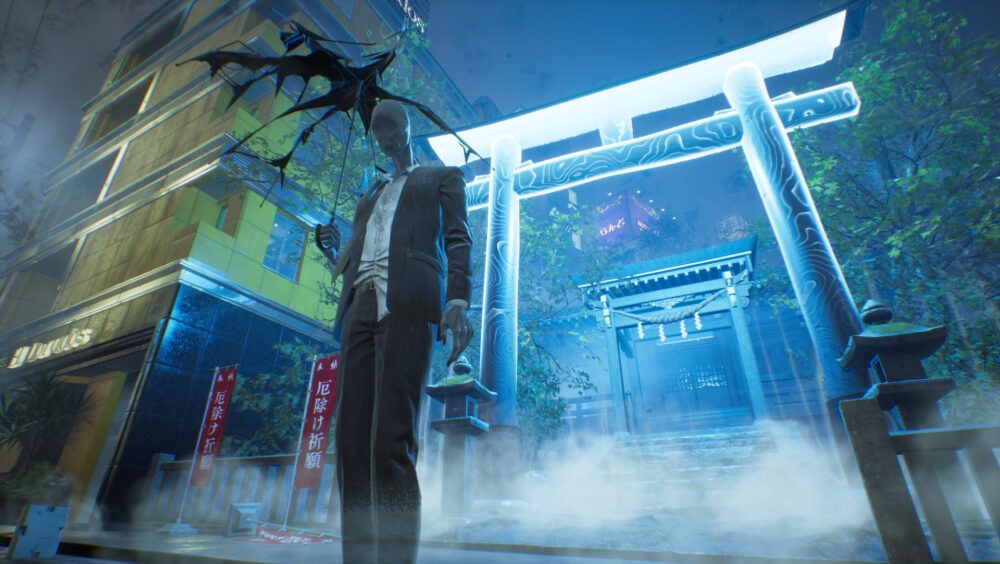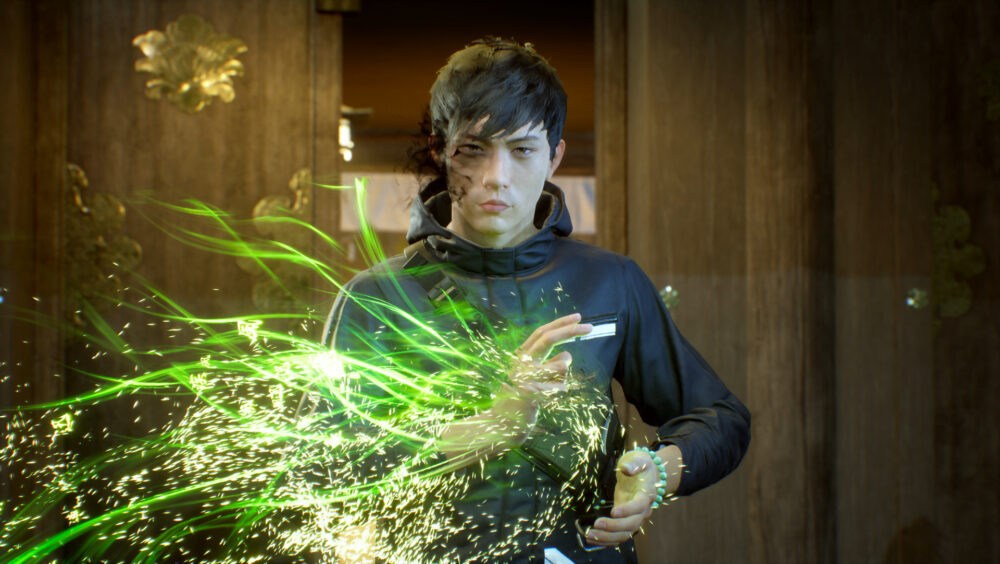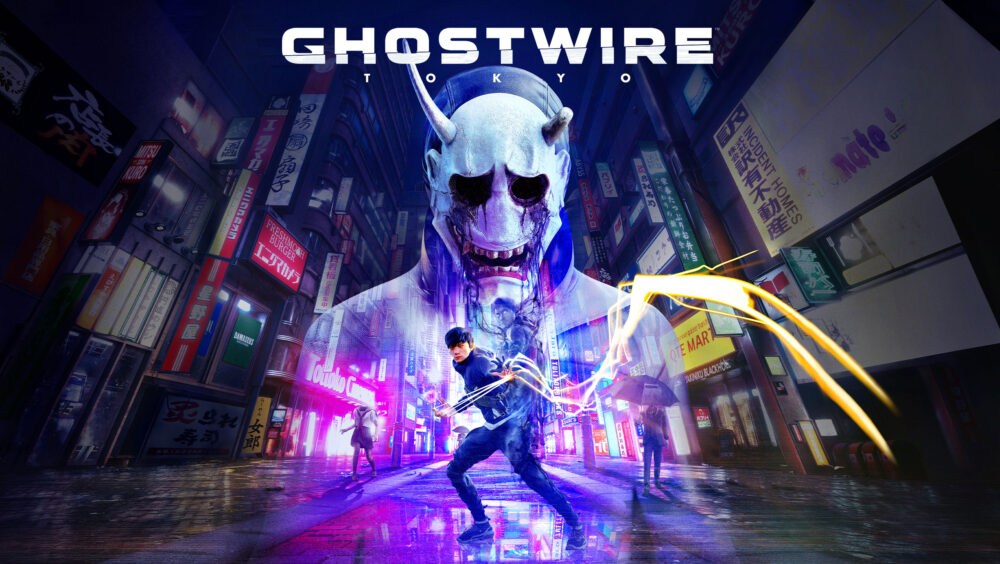Ghostwire: Tokyo is the latest offering from Shinji Mikami’s studio, Tango Gameworks. It features some horror elements but ultimately plays like an action-adventure title. Does it craft a satisfying blend of the two genres? Let’s find out.
Ghostwire: Tokyo takes place in the busy ward of Shibuya. A mysterious fog envelopes the area and causes all of the citizens to disappear, save for Akito, one of the game’s main protagonists. After barely surviving a collision while riding his motorcycle, Akito’s body is inhabited by a spirit detective known only as KK, an act that saves his life. While this saves him from getting taken by the fog, it also grants him supernatural powers. Reluctantly, Akito agrees to keep KK with him as they combat spiritual enemies known as Visitors across Shibuya. Shortly after meeting, the pair encounter a group wearing Hannya masks who take Akito’s sister. They’ll need to work together to save his sister and put an end to the group’s plans.
The story in Ghostwire: Tokyo is shrouded in mystery and unravels slowly as you make your way through the game. It’s not the most original plot and the main antagonist is somewhat cartoonish, but it’s still fun to play through. What makes it even more interesting is how the game uses Japanese folklore in pretty much all aspects of the game. It plays a fairly big role in the side missions and also makes up the roster of enemy types you will encounter throughout.

The gameplay takes place from a first-person perspective and will see you battling with Visitors called using a technique called Ethereal Weaving. Thanks to KK granting you powers, you are able to cast elemental spells at your enemies and when you’ve damaged them enough to reveal their cores, you can rip them out using ethereal strings. It’s all very stylish and the presentation of it makes the combat feel so much more engaging. You’ll also unlock additional elements as your progress through the game, in addition to other weapons such as different types of talismans and a bow and arrows. While a dodge function would’ve fit in quite nicely, Akito and KK do have the ability to block attacks from Visitors. Performing a perfectly-timed block will parry your attacker, staggering and pushing them back, giving you some breathing room.
Aside from the combat, Ghostwire: Tokyo also features some light platforming and vertical gameplay. Not long into the game, you’ll gain the ability to grapple onto Tengu who fly above buildings; this allows you access to the rooftops. There’s also a glide ability that can help you clear a gap between two buildings or just land safely when trying to get back to the streets below.

Being a spirit detective, one of the powers that KK grants you is to see what he sees via Spectral Vision. It’s a pulse ability that not only allows you to see spiritual beings, but it also makes it possible to communicate with animals, and there are a lot of cats and dogs around Shibuya! Spectral vision is incredibly handy when taking on the many side quests that the game has to offer. You trigger these by talking to designated lingering spirits and completing them by helping them resolve whatever may be bothering them. These side quests range from defeating powerful Visitors to capturing Yokai and even cleansing specific locations. Some of them can be pretty simple but a lot of them make use of Japanese folklore to create some rather memorable quests.
Ghostwire: Tokyo also features a number of different collectables that can be found all across the map, and some, if not all, can benefit you. Collecting spirits nets you XP, unique artefacts can be sold for Meika, the game’s currency, and praying to Jizo statues will increase the capacity for one of your elemental attacks. It’s definitely worth exploring sometimes because it can be quite rewarding.
I quite like the gameplay loop of Ghostwire: Tokyo as it made me feel like a paranormal detective of sorts, plus the staggering amount of Japanese folklore in the game is just such a treat. It also strikes a fine balance in being rather eerie in its execution but never really feels too scary. Sure, pretty much every enemy is unsettling, but I still found it quite approachable. However, the game is not without its issues. In the early going, it can feel a little repetitive until you add more weapons and abilities to your repertoire. Additionally, the mission design does feel somewhat unimaginative. Most of the time, you’ll be heading to a location, investigating the environment and then dealing with any enemies that you encounter. The moment to moment gameplay is pretty fun, but the structure of the missions themselves wasn’t particularly memorable.

Visually Ghostwire: Tokyo looks great. Shibuya looks fantastic, even when it’s completely empty. The enemy design is also top-notch and really does a good job of taking existing Japanese folklore and modernising it somewhat. Even some of the visual effects you experience when encountering certain Visitors were a really nice touch. The Kuji-kiri hand gestures are also pretty cool. Depending on how you like to play, there is also a range of graphical options available to favour either visual quality or the frame rate or even a combination of the two. The game also sounds fantastic. From the voice acting to the little audio cues when close to an enemy, to the sound effects when ripping them apart, it does a good job at delivering a satisfying audio experience.
Ghostwire: Tokyo is a great game. The story is quite intriguing, but what will keep you hooked is the gameplay and the way the game embraces Japanese folklore and tradition. However, it is let down somewhat but some uninspired mission design and a little repetition in the early going. Despite this, it delivers a satisfying experience that makes you feel like a paranormal detective and does so with stylish execution.
Grab you copy here https://bethesda.net/en/game/ghostwire-tokyo
Enjoy the review? want to read more of our reviews? then click right here to be whisked away to the realm of our opinions.








You must be logged in to post a comment.